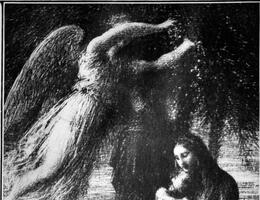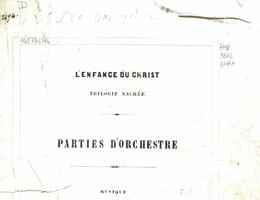L'Enfance du Christ

Sacred Trilogy
Part One: Le Songe d’Hérode (Herod’s Dream)
“Dans la crèche, en ce temps” (“At that time, Jesus, in the manger, had just been born”) (Narrator) - Scene 1: Nocturnal March - Scene 2: Herod’s Aria - Scene 3: “Seigneur” (“Sir!”) (Polydorus, Herod) - Scene 4: Herod and the soothsayers - Scene 5: Duo (the Virgin Mary, Joseph) - Scene 6: Choir of angels, the Virgin Mary, Joseph
Part Two: La Fuite en Égypte (The Flight into Egypt)
Overture - The Shepherds’ Farewell - The Repose of the Holy Family (Narrator)
Part Three: L’Arrivée à Saïs(The Arrival at Saïs)
“Depuis trois jours, malgré l’ardeur du vent” (“For three days, despite the strong winds”) (Narrator) - Scene 1: Duo (the Virgin Mary, Joseph, chorus) - Scene 2: “Entrez, entrez, pauvres Hébreux” (“Come in, come in, you poor Hebrews!”) (father, chorus, Joseph) - Trio for two flutes and harp – “Vous pleurez, jeune mère” (You are weeping, young mother) (father, the Virgin Mary, Joseph, chorus) - Scene 3: Epilogue
On 12 September 1850 the audience at the Salle Sainte-Cécile in Paris gave an enthusiastic reception to L'Adieu des bergers (The Shepherds’ Farewell), supposedly written by a man named Pierre Ducré who had been maître de musique at the Sainte-Chapelle in the seventeenth century. The score was in fact by Berlioz. He later incorporated it into La Fuite en Égypte, completed in 1850; then in 1853-54 he expanded the project to include L'Arrivée à Saïs, and finally in 1854 he added Le Songe d'Hérode, thus forming L'Enfance du Christ. The work was first performed complete on 10 December 1854 in Paris. Although Berlioz himself said that he was not particularly receptive to “early music”, he wrote the text of his “trilogie sacrée” in an archaic style, introduced touches of modality in several of the numbers (overture to La Fuite en Egypte, Herod’s aria “O misère des rois”), stylised what he imagined to be the colours of early music (Trio for two flutes and harp in Part III Scene II, his only piece of chamber music) and ended the work with an unaccompanied chorus. This series of tableaux, sometimes with words spoken by a narrator, is on the whole simple and gentle in tone, with a mixture of meditation and action, as in La Damnation de Faust (1846). It is understandable that listeners who associated Berlioz with thunderous music did not see through the hoax. But this “petite sainteté” stylised “in the manner of old illuminated missals” (Berlioz, letter to his sister Adèle) contains many of his distinctive features: a march (Nocturnal March, Scene 1 of Songe d’Hérode), a fugue (Overture to La Fuite en Égypte), strange, sinuous melodies, equally singular timbral combinations, and also asymmetrical rhythms inherited from his teacher Reicha (metre alternating between triple and quadruple time in the Dance of the Soothsayers in Part I).




